Tennis serve in slow motion
At 6000 fps, you can see just how much the racquet flattens a tennis ball on the serve.
(via devour)



This site is made possible by member support. 💞
Big thanks to Arcustech for hosting the site and offering amazing tech support.
When you buy through links on kottke.org, I may earn an affiliate commission. Thanks for supporting the site!
kottke.org. home of fine hypertext products since 1998.
At 6000 fps, you can see just how much the racquet flattens a tennis ball on the serve.
(via devour)
Tennis great Pete Sampras recently wrote a letter to his 16-year-old self.
There’s more to being a pro than just playing tennis. The more successful you are, the more people will want out of you. It won’t always be something you’ll want to do, and it won’t always be fun. The pressure will be as exhausting as anything you’ll ever do on the tennis court. But as a tennis champion, you have that responsibility. You play tennis because you love the game, not because you love the limelight, so get ready. Think about getting some media training. It’ll go a long way. Luckily, you’ll be out of the game before these things called Twitter and Facebook come around. Be thankful for that. One day you’ll understand what I mean.
Oh, and put the newspaper down. Don’t read what people are saying about you. No good can come of it. And if you do hear or read something negative about yourself, don’t sweat it. Let your racket do the talking.
There’s nothing that distinguishes Sampras’ letter from others of the format, but it got me wondering if these letters from successful people to their younger selves would have the hoped-for impact. It seems to me that success requires struggle, failure, and a bit of stupidity…or if you want to be nice about it, a beginner’s mind. Skipping even some of that might take some of the edge off. Perhaps Sampras should write another letter to his 15-year-old self urging him to ignore any subsequent correspondence.
While reading this otherwise excellent article written by US soccer player Christie Rampone, I discovered a type of diet I’d never heard of before, the blood type diet (italics mine).
Age and parenting make me think about longevity. I definitely believe one big reason for my longevity has to do with the dietary and fitness changes I made after being diagnosed with auto-immune conditions after giving birth to my youngest daughter Reece in 2011. For example, I’ve gone gluten-free and have started to eat to my blood-type. Also, a friend introduced me to a natural ingredient called EpiCor to help strengthen my immune system. I have taken EpiCor daily for the past three years and it has become a beneficial part of my daily routine of rest, recovery, working out, eating healthy, and being in airports and hotels more than my own house.
From Wikipedia, an overview of the diet:
The underlying theory of blood type diets is that people with different blood types digest lectins differently, and that if people eat food that is not compatible with their blood type, they will experience many health problems. On the other hand, if a person eats food that is compatible, they will be healthier.
That theory is, in turn, based on an assumption that each blood type represents a different evolutionary heritage. “Based on the ‘Blood-Type’ diet theory, group O is considered the ancestral blood group in humans so their optimal diet should resemble the high animal protein diets typical of the hunter-gatherer era. In contrast, those with group A should thrive on a vegetarian diet as this blood group was believed to have evolved when humans settled down into agrarian societies. Following the same rationale, individuals with blood group B are considered to benefit from consumption of dairy products because this blood group was believed to originate in nomadic tribes. Finally, individuals with an AB blood group are believed to benefit from a diet that is intermediate to those proposed for group A and group B.”
As you might have already guessed, there is no evidence that eating your blood type is beneficial nor do the claims of differing lectin digestion have scientific merit. Homeopathic nonsense.
Tyler Cowen writes about Steph Curry, the current dominance of the three-point shot, and how the reality of new technology lags in relation to its promise.
What took so long? At first the shot was thought to be a cheesy gimmick. Players had to master the longer shot, preferably from their earliest training. Coaches had to figure out three-point strategies, which include rethinking the fast break and different methods of floor spacing and passing; players had to learn those techniques too. The NBA had to change its rules to encourage more three-pointers (e.g., allowing zone defenses, discouraging isolation plays). General managers had to realize that Rick Pitino, though perhaps a bad NBA coach, was not a total fool, and that the Phoenix Suns were not a fluke.
This longer article on the rise of the three-pointer in the NBA by Tom Haberstroh provides further context to Cowen’s thoughts.
Sam Peterman is a sophomore in high school near Buffalo who runs track. She also has a condition called neurocardiogenic syncope (NCS) that causes her to faint after every race she runs, right into the waiting arms of her father soon after she crosses the finish line.
Dr. Blair Grubb, a professor at the University of Toledo who has studied syncope extensively, characterized NCS in a 2005 article in The New England Journal of Medicine as the autonomic nervous system’s failure to keep blood pressure high enough to maintain consciousness.
Physical activity, he said, pools blood in the lower half of the body, reducing blood flow to the heart. In response, the heart pumps more vigorously. In people with NCS, the brain misreads that as high blood pressure and tries to lower the pressure, which leads to decreased blood flow to the brain and, thus, fainting.
Peterman often does not remember the ends of races — she blacked out the last 60 meters of a recent race — which has prompted her father to wonder why she faints after races and not during. See also No pain, possible gain. (via @atul_gawande)
The Program is an upcoming film about the rise and fall of Lance Armstrong directed by Stephen Frears (The Queen, High Fidelity). It’s based on David Walsh’s book, Seven Deadly Sins: My Pursuit of Lance Armstrong.
This goal by Lionel Messi in the Copa del Rey final over the weekend is just out of this world.
You’ll notice:
1. He takes on three defenders at once and beats them all by himself, even though they had him pinned against the sideline.
2. There is only a brief moment during his run that the ball is more than a foot and a half away from his feet. The combination of his fierce pace and that delicate delicate touch is unstoppable.
3. The ball never gets away from him because by the time that he kicks it, he has already moved to receive it. This is most evident on his final touch, right before he tucks it inside the near post…he’s already moved to the left to receive the pass before he taps it to himself.
4. How did he find the space between the keeper and the near post for that?
5. ARGGFJESNCKGHMEPSCC!!!!!!
Update: ESPN Sport Science breaks down Messi’s goal by the numbers…how fast he accelerated, touches/sec, and the angle at which he shot at goal.
Nick Barnes is a football commentator for BBC Radio Newcastle. For each match he does, Barnes dedicates two pages in his notebook for pre-match notes, lineups, player stats, match stats, and dozens of other little tidbits.
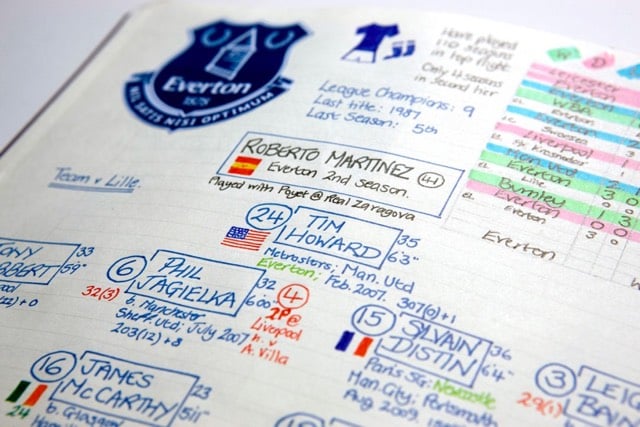
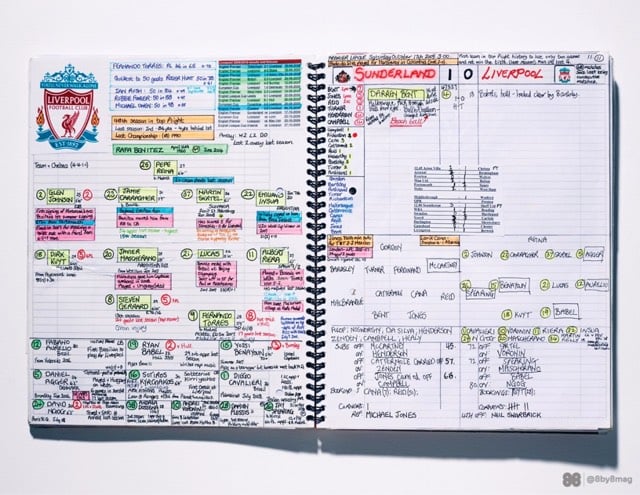
Wonderful folk infographics. NBC commentator Arlo White also shared his pre-match notes. Both men say they barely use the notes during the match…by the time the notes are done, they know the stuff. (via @dens)
In celebration of English footballer David Beckham’s 40th birthday, ESPN commissioned Helen Green to take us on an animated voyage through Beck’s many hairstyles.
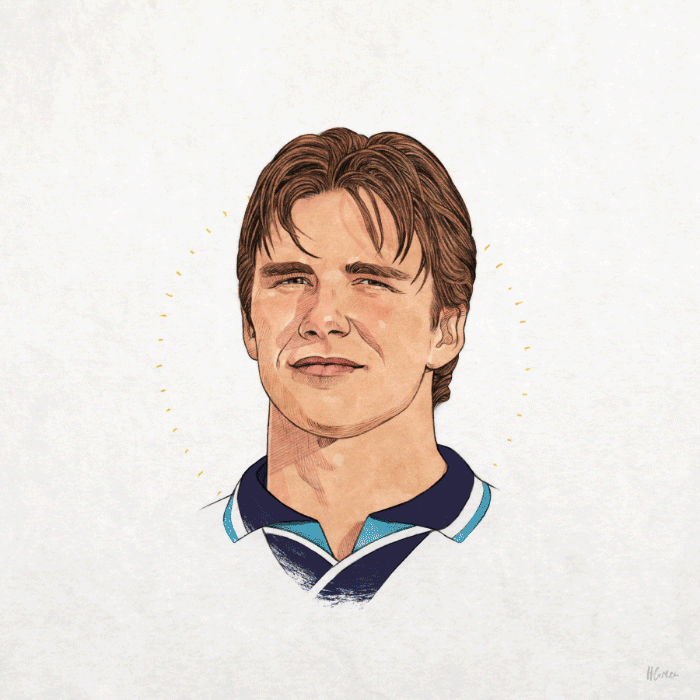
See also every David Bowie hairstyle (also by Green), every Prince hairstyle, and David, a piece of video art by Sam Taylor-Wood of Beckham sleeping for an hour and seven minutes.
Technically, what you’re looking at here is a video shot in 4K resolution (basically 2x regular HD) and at 1000 frames/sec by a Phantom Flex 4K camera which retails for $100,000+. Skateboarders ollie. Dirt bikes spray dirt. Gymnasts contort. Make this as fullscreen as possible and just sit back and enjoy.
My favorite bits were of the gymnasts. In super slow motion, you can see how aerial flips are all about getting your head down as quickly as possible, then snapping your legs around as your head stays almost completely motionless — like a chicken’s! Mesmerizing.
I’d never heard of freeline skates before…they’re like little skateboards, one for each foot. This video shows how they’re used for tricks and such:
That looks hard, much more difficult than skateboarding or inline skates. But maybe not, once you get the hang of it? Can’t beat the portability though…they’d slip right into a small bag when you’re not using them. (via @matiasfrndz)
From Nowness, a brief homage to the single chair lift at one of the oddest and most wonderful ski areas in the US, Mad River Glen in Vermont.
You don’t have a lot of opportunity in life these days to have 10 or 12 minutes alone. Some people think when they come here and they ride the chair, it’s a lonely ride. I never really thought of it that way.
I haven’t checked for sure, but Mad River might be the only ski area in the world with a chairlift that has its own beer.
Update: Here’s what skiing in the trees in 16” of powder at Mad River Glen looks like.
Judging by interviews, neither Wayne Rooney or Lionel Messi seems like the smartest tool in the shed, but they both possess a keen mind for football as Simon Kuper explains. Messi, who appears to listlessly sandbag his way through the early part of matches, is actually using the time to size up his opponent:
It was a puzzling sight. The little man was wandering around, apparently ignoring the ball. The official explained: “In the first few minutes he just walks across the field. He is looking at each opponent, where the guy positions himself, and how their defense fits together. Only after doing that does he start to play.”
And Rooney uses visualization (or as Shaq would call it, dreamful attraction), just like Allen Iverson:
“Part of my preparation,” he told the writer David Winner for ESPN The Magazine in 2012, “is I go and ask the kit man what colour we’re wearing, if it’s red top, white shorts, white socks or black socks. Then I lie in bed the night before the game and visualize myself scoring goals or doing well. You’re trying to put yourself in that moment and trying to prepare yourself, to have a ‘memory’ before the game. I don’t know if you’d call it visualizing or dreaming but I’ve always done it, my whole life.”
A footballer’s exceptional visual memory was on display recently when FC Barcelona’s Xavi Hernandez was quizzed about 5 particular goals he’s scored out of 57 total across almost 500 matches for his club:
He gets them all correct, even what the scores were when they happened, the final scores, who else scored in each match, and even the team’s position in La Liga.
A quick P.S. for Messi. On Feb 16, 2015, Zito Madu wrote an article titled Is Lionel Messi even good anymore?
Plainly put, Messi is a shadow of his former self. He’s much more cynical, more selfish and power-hungry. How else can the departure of Martino and friction with Enrique be explained? It’s a power play by a man who feels his powers waning. Consider: after Barcelona’s 5-0 victory against Levante, Messi had only managed 37 goals and 18 assists in all competitions. A far cry from the player who once scored 82 goals in one season.
At 27 years old, we might be witnessing the twilight of Messi’s career. It’s a shame for a player who seemed to be on a tear just a few years ago.
It was a weirdly cynical take that contained a kernel of truth. A little over a month later on Mar 23, Jeff Himmelman wrote a piece called Lionel Messi Is Back On His Game.
But in the new year, Messi has finally started to look like himself again; he has been on fire, racking up hat tricks and leading the league in scoring. His legs and his extraordinary bursts of energy — the engine of his game — are back, and a move to the right flank from the congested middle has freed him to do what he does best: making slashing runs at defenders with speed, creating space and chances.
On the evidence of the last week, it has become possible to wonder whether Messi might actually be better than ever. The best reason to think so was the first half of Barcelona’s game against Manchester City on Wednesday, in the round of 16 of the Champions League European club championships. From the start, Messi spun passes into tight spaces and flew up and down the field with a boyish abandon that was nowhere to be found last year.
In that Man City game, Messi nutmegged both Milner and Fernandinho:
In a recent study released by CIES Football Observatory, Messi was judged to be the best forward in the world over the first three months of 2015. Ronaldo? 29th place. Eep.
Update: Real Madrid keeper Iker Casillas demonstrates his remarkable memory, recalling scores from matches from up to 15 years ago he didn’t even play in. (via @adamcohen15)
This article on the science of free diving is fascinating. Boyle’s Law predicted that the human body couldn’t survive depths past 100 feet — after which, the lungs would rupture — but millions of years of evolution has equipped the human body with all sorts of tricks to survive at depths of over 900 feet.
Lundgren, among others, demonstrated how these phenomena might counteract Boyle’s law. He recruited volunteer firemen from a fire brigade in the Swedish city of Malmo, submerged them up to the neck in water, and used a heart catheter to measure the increase in blood circulation in the chest. Lundgren discovered the body was able to counteract the increased outside water pressure by reinforcing vessels in the walls of the lungs with more blood, in much the same way we increase tire pressure by adding more volume of oxygen to the inside of a tire.
Boyle’s Law had not been overturned. Scientists simply hadn’t taken into account the effect this counterforce could exert to allow survival underwater. “A lot of blood, much more than was usually thought, can be transferred from the blood circulation out in the tissues into the blood vessels of the lung,” Lundgren said, placing that amount at about half a gallon. The extra, densely packed blood can act as a bulwark, exerting a counterforce against the increased pressure pushing inward by the water.
Martin Scorsese is reportedly set to direct a biopic on Mike Tyson with Jamie Foxx in the title role. Tyson has compiled a video of each of his 44 knockouts and wants his fans’ help in choosing his top 10 for Foxx to study.
The top 10 from this video are definite contenders.

Blake Harris, the author of Console Wars, has written a piece on how NHL ‘94 came to be. For those unaware, NHL ‘94 is one of the greatest sports video games ever created. This is the sort of attention to detail that made it so great:
For example, it could emulate the ambience of a game day NHL arena by including the proper organ music. The problem, though, was that each team’s organist played different songs. ‘That’s not a problem, actually,’ explained Dieter Ruehle, the organist for the San Jose Sharks (and previously for the Los Angeles Kings), ‘I can do that.’ True to his word, Ruehle provided EA with organ music for every team; and he didn’t just provide all of their songs, but also noted which music was blasted during power plays, which tunes were used to celebrate goals, and all the other inside info needed to make each arena feel like home. Ruehle was so diligent about getting it right and capturing that home crowd essence, that during a recording session at EA’s sound studio he asked:
‘The woman who plays the organ for the Washington Capitals has arthritis; would you like me to play the songs how they are meant to be played, or the way that she plays them because of her condition?’
‘Definitely the way she plays it!’ Brook answered, after a laugh.
I think I might have to bust out the Genesis this week. Anyone wanna come over?
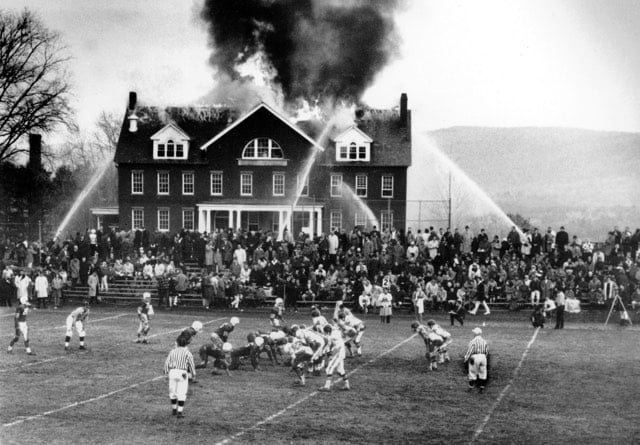
Ok, this is one of the strangest photos I’ve ever seen. In the background, there’s a building on fire and in the foreground, there’s a football game going on like there’s not a building on fire right there. From their photographic recap of 1965, In Focus has the story:
Spectators divide their attention as the Mount Hermon High School football team in Massachusetts hosts Deerfield Academy during a structure fire in the Mount Hermon science building on November 24, 1965. The science building was destroyed, and Mount Hermon lost the football game, ending a two-year-long winning streak.
Update: The photo above reminded some readers of this photo, taken by Joel Sternfeld in 1978.

You’ll notice the fireman buying a pumpkin while the house behind him burns, although there’s a bit more to the story than that.
In 1996, a building burned outside the stadium during the LSU/Auburn game:
(via @slowernet & @davisseal)
Update: Sarah Lyall of the NY Times goes long on the Mount Hermon photo, which was very much real and celebrated when it was initially published.
Even at the time, when the photograph was reprinted around the world, people thought it was too weird to be real. “My colleagues maintain it is a real picture, but I believe it is of the April fool type,” wrote Phil F. Brogan, an editor at The Bulletin newspaper in Bend, Ore. (“I can assure you that the picture was not faked,” replied Arthur H. Kiendl Jr., the headmaster of Mount Hermon, the Massachusetts prep school where the game took place.)
In fact, the photograph, of Mount Hermon’s game against Deerfield Academy on Nov. 20, 1965, was an instant classic. Though the photographer, Robert Van Fleet, never received much in the way of money for it, it was named the Associated Press sports photograph of the year. It was featured on the back page of Life magazine. It was reproduced in dozens of newspapers and magazines across the United States, including The New York Times, often accompanied by supposedly amusing captions about Rome burning, the teams’ “red-hot rivalry” and the like.
Koa Smith rides in the barrel of a wave for almost 30 seconds…it just goes on and on and on.
This video is a bit misleading. The ride is shown twice but the first time through it’s slowed down so it lasts more than a minute. The full-speed replay starts at 2:01 and is still impressive. (via digg)
Here are 64 goals scored by FC Barcelona legend Lionel Messi, presented simultaneously in one frame.
Fusion’s Cara Rose DeFabio has dubbed this type of video The Superfuse.
Director Errol Morris has directed six short films for ESPN collective titled “It’s Not Crazy, It’s Sports.” The films will air on March 1 and then be released online during the following week. The trailer:
The films’ subjects include Mr. Met, streakers, sports memorabilia fanatics, an electric football league, and Michael Jordan’s stolen jersey. I’ll post the films here as they’re released online. Morris previously did a film for ESPN about the sports-themed funerals of die-hard fans.
Update: Grantland has posted the first short film in the series about an electric football league that’s been running in a NY basement for over 30 years.
Update: All of the Morris’ shorts have now been posted on Grantland. Go. Watch.
If you’ve ever noticed most ski trail maps look kinda the same, the reason is many of them have been painted by a single individual: James Niehues.
Each view is hand painted by brush and airbrush using opaque watercolor to capture the detail and variations of nature’s beauty. In many instances, distortions are necessary to bring everything into a single view. The trick is to do this without the viewer realizing that anything has been altered from the actual perspective.
Here’s a selection of his work:


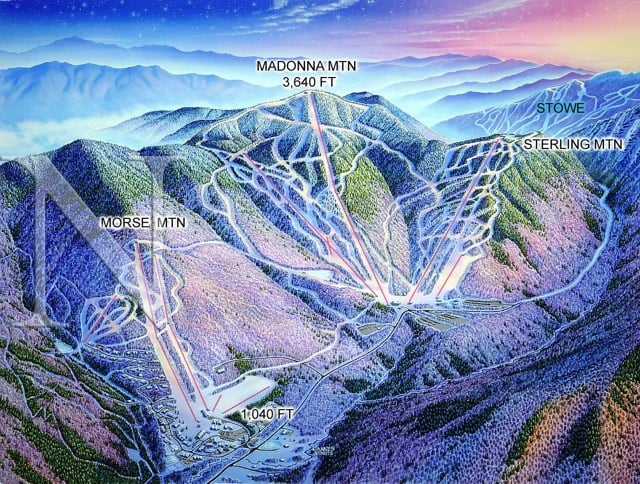
Free diver Guillaume Néry looks like an astronaut floating around in space in this underwater video.
See also this surrealist free diving video and Néry’s underwater base jump. (via ★interesting)
Back in September at the beginning of the NFL season, I wrote a post called I’m quitting football.
I’ve been a steadfast fan of NFL football for the past 15 years. Most weekends I’d catch at least two or three games on TV. Professional football lays bare all of the human achievement + battle with self + physical intelligence + teamwork stuff I love thinking about in a particularly compelling way. But for a few years now, the cons have been piling up in my conscience: the response to head injuries, the league’s nonprofit status, the homophobia, and turning a blind eye to the reliance on drugs (PEDs and otherwise). And the final straw: the awful terrible inhuman way the league treats violence against women.
It’s overwhelming. Enough is enough. I dropped my cable subscription a few months ago and was considering getting it again to watch the NFL, but I won’t be doing that. Pro football, I love you, but we can’t see each other anymore. And it’s definitely you, not me. Call me when you grow up.
So how did I do? I ended up watching four games this season: a random Sunday night game in week 15 or 16, the Pats/Ravens playoff, the Pats/Colts playoff, and the Super Bowl. I’ve been watching and rooting for the Patriots for the past, what, 14 or 15 years now. And more to the point, I’ve been following the Brady/Belichick storyline for almost that long and once it became clear the Pats had a great shot at winning it all, not watching the final acts was just not going to happen, NFL bullshit or not. It would be like putting down one of the best 1200-page books you’ve ever read with two chapters to go and just saying, yeah, I’m not going to read the end of that. And that game last night…I felt *incredible* when Butler intercepted that pass. Life is full of many greater, more fulfilling, and more genuine moments, but there’s no feeling quite like the one when you realize your team has won, especially when that victory has been snatched, semi-literally, from the jaws of near-certain defeat.
But that’s ultimately weak sauce. I don’t feel justified about watching just because I really enjoyed it. I made a commitment to myself and didn’t honor it. I believe the NFL is still a terrible organization and isn’t worth supporting with my attention. For whatever it’s worth, I’m going back to not watching next year, and I hope I fare better.
Update: Bill Simmons, in an epic recap of the final 12 minutes of the Super Bowl, echoes what I was getting at above.
When you’ve been rooting for the same people for 15 years, at some point the stakes become greater. You want that last exclamation-point title. (Just ask Spurs fans.) You want to feel like you rooted for a dynasty, or something close to it, instead of just “a team that won a couple of times.” You want to say that you rooted for the best coach ever and the best quarterback ever, and you want to be constantly amazed that they showed up to save your sad-sack franchise at the exact same time.
Last week, Tommy Caldwell and Kevin Jorgeson completed the first free ascent of The Dawn Wall on Yosemite’s El Capitan. It’s been called the most difficult climb ever completed. The NY Times has some good coverage of the climb, including an interactive feature/map of the wall and a 3.4 gigapixel zoomable photograph of the climb in progress. Here’s a 3-minute video of Caldwell navigating Pitch 15, one of the most difficult sections of the climb:
“The crux holds of pitch 15 are some of the smallest and sharpest holds I have ever attempted to hold onto,” Tommy wrote on his Facebook page. Four unique camera angles reveal those minuscule holds and the 1,300 feet of exposure under Tommy’s precarious foot placements. While multiple pitches of extremely difficult climbing remained above, the completion of pitch 15 was considered the last major hurdle to the eventual success of this seven-year project.
It gets intense around 1:30. Jesus, my palms are sweating right now. I feel like I’m gonna pass out! (via @sippey)
Update: I totally didn’t notice but several people pointed this out on Twitter: Caldwell only has 4 fingers on his left hand. He cut off his index finger with a table saw, got it reattached, and then removed again so it wouldn’t hinder his climbing.1
And as if completing the most difficult climb in the world with only 9 fingers and discarding a finger to pursue a passion isn’t quite enough for one life, Caldwell and some friends were captured by rebels while climbing in Kyrgyzstan. Caldwell helped save the group by pushing one of their captors over a cliff.
All the scheming comes to nothing, until at one point three of the rebels go away leaving a lone man in charge of the captives as they climb a steep ridge. Then, near the top …
Tommy Caldwell: Our captor sees that the hillside is easing off and he starts to run ahead. He has been really scared this whole time on this cliff because he’s not a climber. So I asked Beth if she thinks I should do this.
Beth Rodden: And at that point I just thought that this was our best opportunity.
Tommy Caldwell: So I ran up behind him and grabbed him by his gun strap and pulled him over the edge. We were probably about 2,000 feet (610 meters) above the river, but it’s a cliff that is pretty sheer. We saw him fall 20 feet (6 meters), bounce off this ledge, and then fall basically into the black abyss below. I totally panicked. I broke down. I couldn’t believe I’d just done that, because it’s something that I never morally thought I could do and I never wanted to do. And Beth came up and, you know, gave me a lot of comfort as well as Jason and John.
Beth Rodden: I told him he’d just saved our lives and now we had this opportunity to run and hopefully find the Kyrgyz Army.
Reading that story makes my palms sweat almost as much as watching the video. Jesus.
Little known fact: there’s a photo of Caldwell’s severed finger next to the definition of “dedication” in the dictionary.↩
People ask me why I ski.1 A: Because sometimes it’s as insanely fun as this guy makes it look.
He. Skis. THROUGH THE MOUNTAIN. Also, if you can, pause it right after he jumps off the lift platform…the kid on the lift with his dad is like ( ゚o゚).
No one has ever asked me this. No one ever asks people questions like this. “People ask me…” is a phrase writers use to create a sense of an ongoing story. It’s better than “This is a cool video”…you can only use that one so many times. ↩
This is the craziest thing I’ve ever seen anyone do on skis: Cody Townsend skiing down a super steep face in a space between two rock walls no wider than a supermarket aisle. Powder Magazine called it “The Line of the Year”.
They forgot to put “Batshit Crazy” before the word “Line”. (via devour)
This dive, by Leeds United midfielder Adryan in match against Derby County, might be the worst dive of all time.
He’s flopping around like Sonny Corleone getting shot up at the toll booth in The Godfather. Hilarious.
I know, I know, no football.1 But I could not help seeing this catch last night by NY Giants receiver Odell Beckham. Many are calling it the best catch anyone has ever made in the history of the NFL.
As a player, how do you prepare yourself for making the greatest catch in history? It would be easy to dismiss this catch as a lucky fluke…one-handed, fighting off a defender, just gets it by his fingertips. But here’s the thing: Beckham practices exactly this catch:
Luck is what happens when preparation meets opportunity. Preparation, kids. Preparation.
Aside from the occasional highlight, I still have not watched a single minute of NFL football this year. It’s not been easy, particularly on Sunday nights, where all I want to do most of the time is flip on the game and veg out with a Collinsworth/Michaels soundtrack. ↩
Whoa, how did I miss this? Steve Carell, check. Channing Tatum, check. Mark Ruffalo, check. Based on a true story, check. Positive reviews, check.
Currently on the to-do list: watch every single movie produced by Annapurna Pictures, a production and distribution company founded by Megan Ellison, who is Oracle founder Larry Ellison’s daughter. Look at this list of directors they’re working with: Kathryn Bigelow, Paul Thomas Anderson, Spike Jonze, David O. Russell, Richard Linklater.
From the Guardian’s photo editor, an annotated list of the 25 best photographs of Muhammad Ali. My favorite is by Neil Leifer:
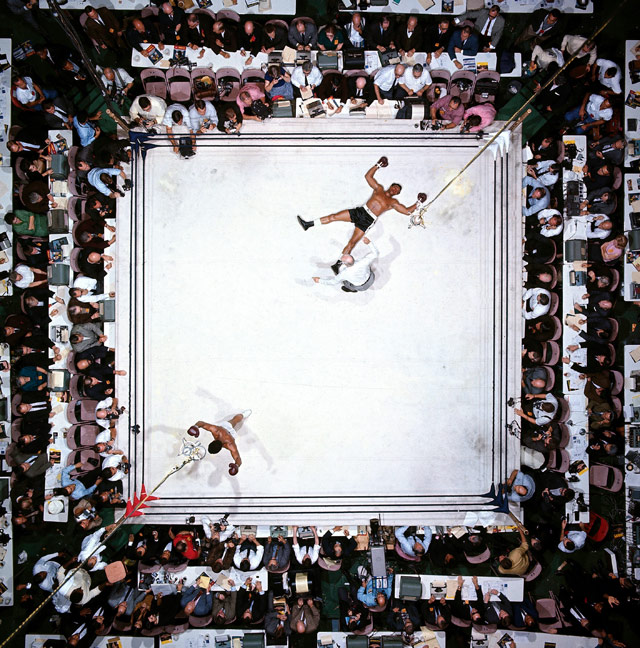
(via @DavidGrann)
Stay Connected